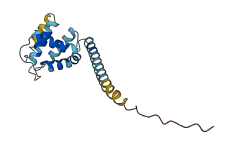Descriptions
The autoinhibited protein was predicted that may have potential autoinhibitory elements via cis-regPred.
Autoinhibitory domains (AIDs)
Target domain |
|
Relief mechanism |
|
Assay |
cis-regPred |
Accessory elements
No accessory elements
Autoinhibited structure

Activated structure

1 structures for Q01249
| Entry ID | Method | Resolution | Chain | Position | Source |
|---|---|---|---|---|---|
| AF-Q01249-F1 | Predicted | AlphaFoldDB |
No variants for Q01249
| Variant ID(s) | Position | Change | Description | Diseaes Association | Provenance |
|---|---|---|---|---|---|
| No variants for Q01249 | |||||
No associated diseases with Q01249
No regional properties for Q01249
| Type | Name | Position | InterPro Accession |
|---|---|---|---|
| No domain, repeats, and functional sites for Q01249 | |||
Functions
1 GO annotations of cellular component
| Name | Definition |
|---|---|
| type III protein secretion system complex | A complex of approximately 20 proteins, most of which are located in the cytoplasmic membrane that carries out protein secretion in the bacterial type III secretion system; type III secretion also requires a cytoplasmic, probably membrane-associated ATPase. |
No GO annotations of molecular function
| Name | Definition |
|---|---|
| No GO annotations for molecular function |
1 GO annotations of biological process
| Name | Definition |
|---|---|
| protein secretion by the type III secretion system | The process in which proteins are transferred into the extracellular milieu or directly into host cells by the bacterial type III secretion system; secretion occurs in a continuous process without the distinct presence of periplasmic intermediates and does not involve proteolytic processing of secreted proteins. |
No homologous proteins in AiPD
| UniProt AC | Gene Name | Protein Name | Species | Evidence Code |
|---|---|---|---|---|
| No homologous proteins | ||||
| 10 | 20 | 30 | 40 | 50 | 60 |
| MTVTLNRGSI | TSLMSSSQAV | STLQPAASEL | KTQLEHKLKS | ESAEKTREVL | WQQYYASNPP |
| 70 | 80 | 90 | 100 | 110 | 120 |
| DHAVLEVLAT | PVREALLARF | GQHQGPVVPA | IDLPELRSVL | QQFDSFGKRR | EAILLQVLEG |
| 130 | 140 | 150 | 160 | ||
| IKPNESQVGL | PYLSELINKE | LMILLPYNSI | VDSLLHNSHQ | IDMET |
